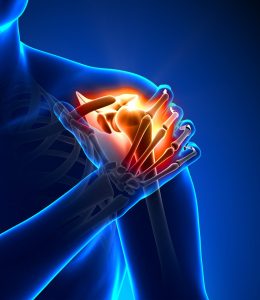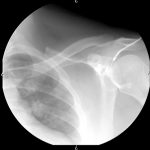
Copyright: decade3d / 123RF Stock Photo
DISCLAIMER – Just to re-emphasize the point, this information is provided as a record of my particular experiences and should not be construed as medical advice. Each surgeon, patient, surgery, and recovery protocol is particular to that situation.
In December 2016 I injured my shoulder. When I finally got it checked out including an arthrogram MRI, it was classified as a type 3 SLAP tear, bordering on 4. (Update 4/26/2017: Once my surgeon got in and looked at it, he said that it was actually a grade four tear, and the first one that he had ever seen. Go me for tearing my shoulder the best I could!) While the grading for these tears is not really “higher numbers are worse”, 2 and 4 do tend to require surgery more often and 4 is fairly rare. It’s really a classification of type more than severity, though a 4 is basically ‘grade 2 with some additional tearing to the bicep tendon’. Additionally, while the MRI is very helpful you never know for sure what the damage looks like and what needs to be done until the surgeon can go in and actually take a look. For me, it turned out to be somewhat worse than we thought. Based on that, I am already glad that I have the surgery even though it will likely be taking me longer to recover. More details and suggestions for surgery day are below.
While searching around for information on the surgery and recovery I came across Neely Quinn’s experiences at TrainingBeta.com. I thought I would go ahead and share mine as well because hers helped me so much to feel prepared and make a good decision. The link will take you to the first of her posts but take a look around the site and you will find several more including a 12 month report. As of this writing, I am still at the beginning of my journey but I do know that our experiences are already different.
How did it happen?
The injury occurred in a martial arts class during partner drills. This particular drill requires you to sit on the ground with your back against a wall, feet splayed out straight in front of you. Your partner meanwhile attacks you in this case just with punches. Your goal is to defend yourself and stand up as quickly as possible getting away from the attack. We did this a number of times and I decided to try something a little different on this particular round of the drill.
This time when my attacker came in, I trapped and straightened his arm then pulled towards me to set him off balance. Then I shifted towards him and got to my feet as I extended my arms away and out to my left pushing him with his straightened arm. This worked great except that as he fell back either he held on or I did. I immediately heard and felt a loud pop in my shoulder along with sharp pain.
How did I respond?
When it popped it definitely hurt and i knew something was wrong. I finished out the class, about 20 minutes, and I tried to stretch it during that time. I thought I could do the equivalent of “walking it off”. Punching the heavy bag felt awful and I had to limit the use of my left arm. I was convinced, however, that it was going to get better. It really did not feel terrible especially compared to some of the ankle injuries I had had in the past or even my AC joint separation.
When did I get it looked at?
It was clearly injured so I did take some time away. I ended up giving it about four weeks expecting it to get better the whole time. Unfortunately it never did and in fact got slowly worse and worse. I was able to do less and less as time went on so I decided I had better get it looked at. An urgent care visit led to a specialist. I had seen Dr. Chad Zooker for my AC joint problem previously and really liked him. As an active crossfitter, he knew the sort of lifestyle I wanted to get back to. I have to admit, in retrospect I wish I had gone to him sooner rather than just trying to let it rest but it’s one of those things you just don’t know until you have to do it. It really did not seem to be as bad of an injury as it turned out to be.
Physical therapy, arthrogram, surgery, oh my!
Dr. Zooker performed an O’Brien’s test on me (amongst others) and called me a “textbook case”. Basically, that identifies a near 100% chance for a SLAP (superior labral anterior posterior) tear. Basically it’s a tear of the labram on the top side (superior), running from front to back (anterior posterior). The difficulty then becomes in determining what kind. In an effort to avoid surgery unless it was definitely necessary, he had me go through a process of physical therapy first. At the same time we decided to set up a specialized MRI called an arthrogram.
Go here for more information on what the arthrogram was like.
My physical therapist was great and definitely got me rolling, but based on the injury, my level of strength in different areas, and the pain I was feeling in different positions, he felt we were likely to end up with surgery.
Thanks to various timing issues and some trips that we were going on (both work and pleasure), I ended up not getting in as many physical therapy sessions as I had hoped. When the arthrogram came back Dr. Z called me immediately because it was pretty definitive.
Could I have avoided surgery?
This is one of those cases where it depends. As I understand it a 30-year-old has good success with surgery, a 50-year-old not so much, and a 41-year-old is somewhere in the middle. With the specific surgery that was being done to me I had a good chance of positive results. That said, a torn biceps tendon does not exactly require repair; it really depends on what you want to do and your activity level.
For me personally I wanted to get back to back squats, fighting, ground combat, overhead pressing, etc. and this was the way to be able to do that safely and with strength. I really think that the decision to repair this or not depends on the individual and their goals. I plan to be highly active my entire life. If all you are worried about is jogging, shooting some light hoops, or things like that then it may not be necessary for you.
(Update 4/26/2017: OK so first thing-I kept second-guessing this over and over again. It wasn’t that it didn’t make sense for me, just for some reason I was really frustrated knowing how long it would take me to get back to doing things. However, with the pain I was feeling I was unable to do quite a bit of what I wanted to. When I stretched out my arm to catch a baseball a little outside my wing span, my shoulder lit up with pain. When I tried to jump and get a rebound playing basketball with coworkers, my shoulder lit up with pain again sometimes to the point that I had to stop for a minute and let it pass. I never tried tennis but even such simple moves as putting my hand behind me and pushing myself up out of bed give me intense pain. Long story short-it was definitely impacting my life and I still second-guessed doing the surgery.
The second part of the update is this-after having had the surgery and finding out just how bad my shoulder was I am extremely happy that I went through with it. This isn’t something that was going to heal on its own and I would have been dealing with not just the pain but range of motion and movement restrictions for the rest of my life. This way I have a very good chance of doing all of the things I want to. And honestly, even if I continue to have pain but regain strength and range of motion enough that I can be active again then I will consider that a success.)
Going Forward
This Thursday the 20th is my surgery, set for the afternoon. We have my brace, compression socks, an ice machine, and a list of movies picked out. Here we go!


